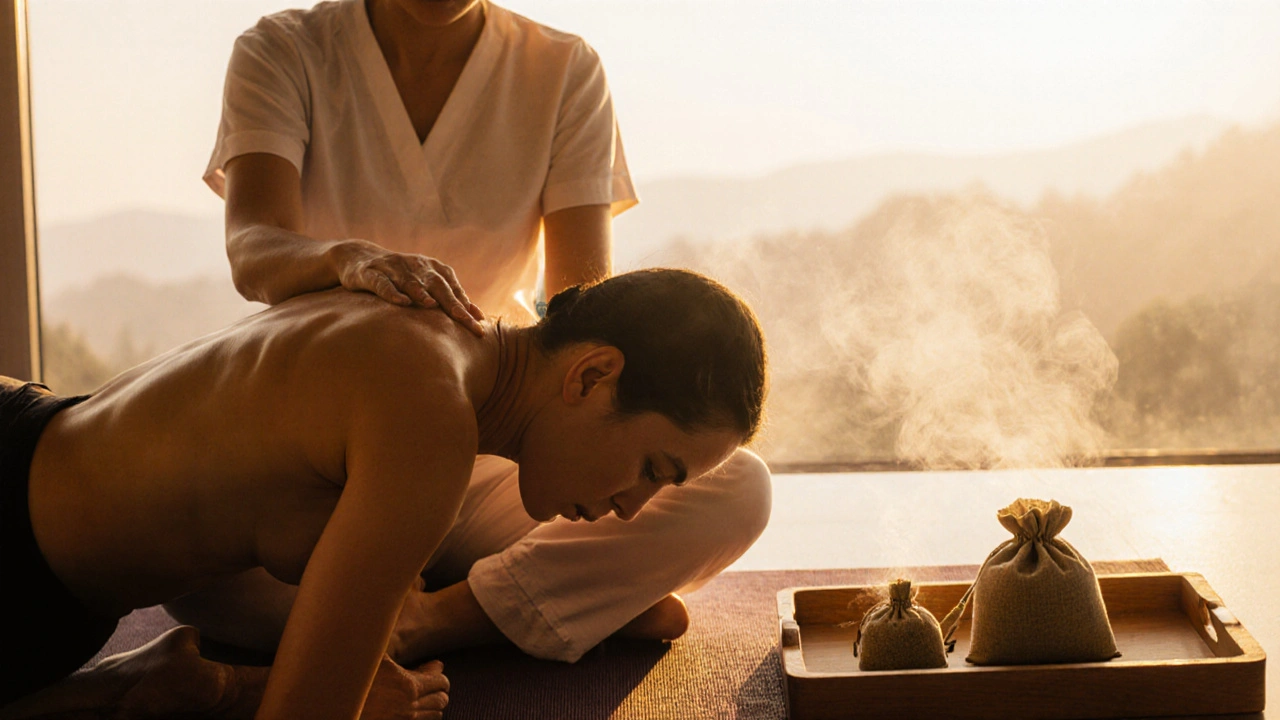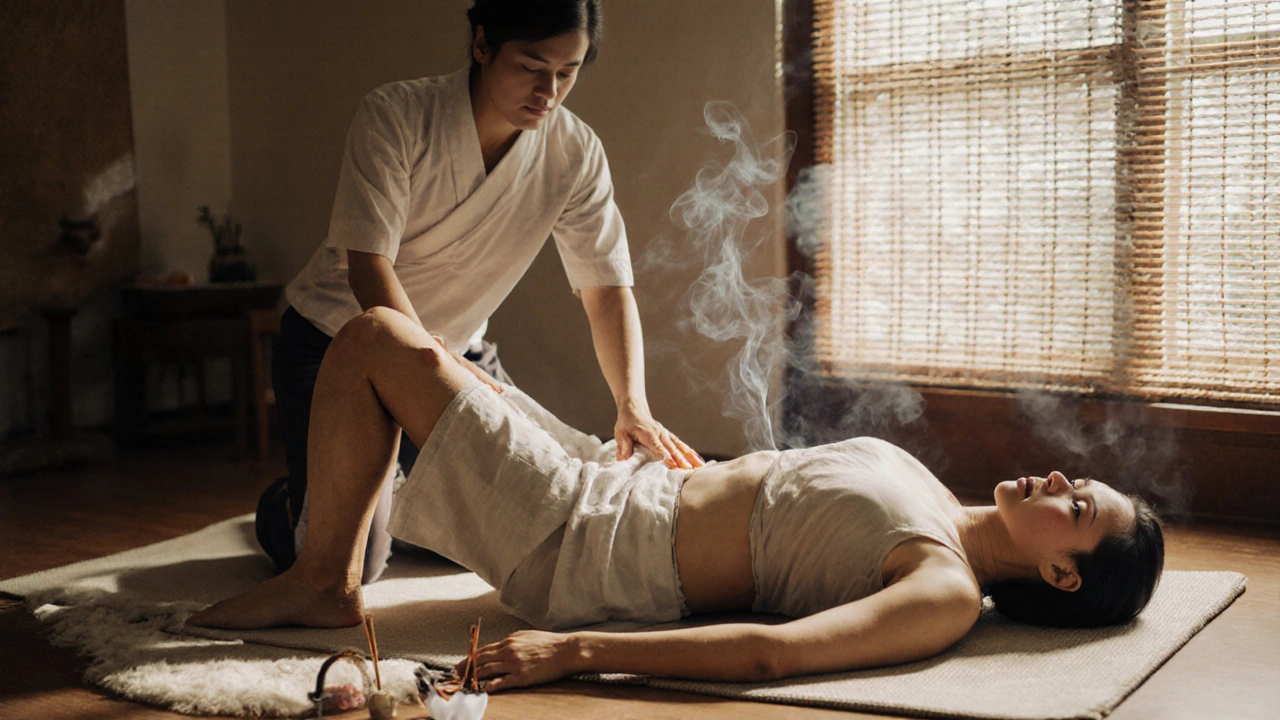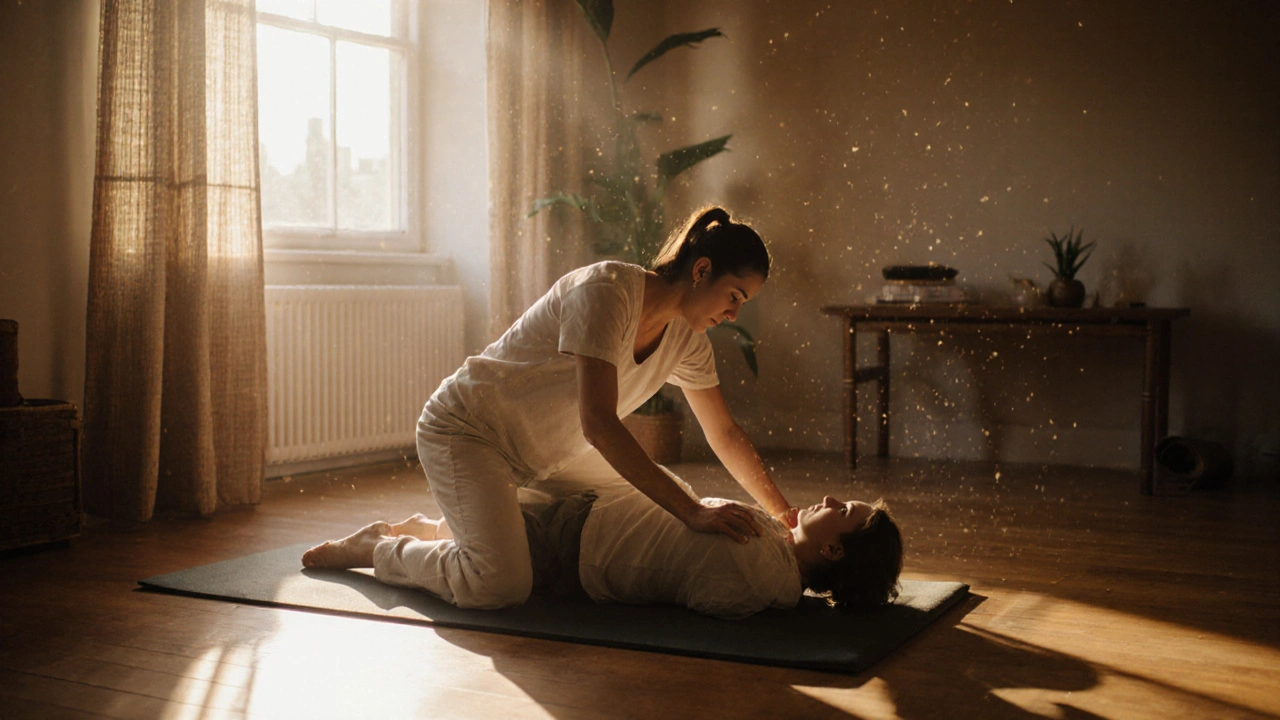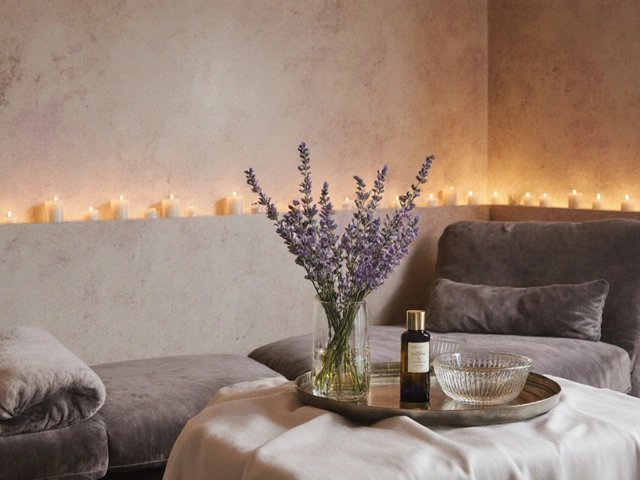You’ve probably seen it: someone lying on a mat, arms and legs stretched in strange positions while a therapist pushes, pulls, and presses with calm precision. No oils. No music. Just deep, rhythmic pressure and a quiet intensity. That’s Thai massage-and it’s not what most people expect. If you’ve ever wondered what makes it different from a Swedish massage or why people swear by it, you’re not alone. There’s more to Thai massage than just stretching. In fact, there are several distinct styles, each with its own rhythm, focus, and feel. The trick is finding the one that matches your body, your goals, and your tolerance for pressure.
What Exactly Is Thai Massage?
Thai massage isn’t just a massage-it’s a full-body therapy rooted in over 2,500 years of traditional medicine. Unlike Western massages that focus on muscles and knots, Thai massage works along energy lines called sen lines, which are similar to acupuncture meridians. Practitioners use their hands, thumbs, elbows, knees, and even feet to apply pressure, stretch your limbs, and guide your body into yoga-like positions. You stay fully clothed, usually in loose cotton pants and a t-shirt, and lie on a padded mat on the floor.
It’s not relaxing in the quiet, candlelit way you might picture. It’s active. Invigorating. Sometimes intense. But if you’ve ever felt stiff after sitting at a desk all day, or if your shoulders feel like they’re holding your stress hostage, Thai massage can reset your body in ways other therapies can’t.
Why People Love Thai Massage
People don’t just do Thai massage because it’s trendy. They stick with it because it works. Here’s what most clients notice after just one session:
- Immediate relief from tight hips, lower back pain, or stiff necks
- Improved flexibility-even if you haven’t touched your toes in years
- Deeper breathing and reduced anxiety after just 60 minutes
- Longer-lasting results than a typical Swedish massage
One regular client from Brighton, Mark, told me he started coming after a cycling injury left him with chronic knee stiffness. After three sessions of Thai massage, he could bend his knee fully again-no physio needed. That’s not an outlier. A 2021 study in the Journal of Bodywork and Movement Therapies found that participants with chronic lower back pain saw significant improvement after just eight weekly Thai massage sessions, with effects lasting over three months.
The Four Main Styles of Thai Massage
Not all Thai massage is the same. Over time, different schools developed across Thailand, each with its own emphasis. Here are the four you’re most likely to encounter:
1. Traditional Northern Thai Massage
This is the original form, passed down in temples in Chiang Mai. It’s slower, deeper, and more meditative. Practitioners focus on energy lines and use their thumbs and palms to apply steady, sustained pressure. You’ll feel more like you’re being gently guided through a series of stretches than pushed into them. Ideal for people who want to unwind without being overstimulated.
2. Southern Thai Massage (Bangkok Style)
Think of this as the high-energy cousin. In Bangkok, massage schools trained therapists to work quickly and with more force. This style uses elbows and knees to apply deeper pressure, especially along the spine and legs. It’s common in urban spas and tourist areas. If you like a firm, rhythmic massage that leaves you feeling loosened up-and maybe a little sore the next day-this is your pick.
3. Herbal Compress Massage
This isn’t a standalone style, but a popular add-on. Hot herbal bundles-filled with lemongrass, turmeric, kaffir lime, and other plants-are pressed against your body. The heat opens your pores, the herbs penetrate your skin, and the steam helps reduce inflammation. Many therapists combine this with traditional Thai massage for a deeply soothing experience. Great for arthritis, muscle soreness, or anyone recovering from travel.
4. Thai Yoga Massage
This version is the most physically demanding-for both you and the therapist. It’s essentially assisted yoga. The therapist moves you through a sequence of stretches, holding your limbs and guiding your spine into deep flexes and twists. You’ll feel like you’ve done a full yoga class without lifting a finger. Best for athletes, dancers, or anyone with chronic stiffness. Not recommended if you have joint issues or are pregnant.
Which Style Is Right for You?
Choosing the right style comes down to what you’re trying to fix-and how much intensity you can handle.
- For stress relief and gentle release: Go with Northern Thai. It’s calm, slow, and grounding.
- For deep muscle tension or sports recovery: Choose Southern Thai. It’s the most effective for breaking up knots.
- For inflammation, joint pain, or recovery from illness: Add herbal compress to any style-it’s like a warm, aromatic hug for your muscles.
- For flexibility or mobility goals: Thai Yoga Massage is unbeatable. But be honest with your therapist about your limits.
First-timers often worry it’ll be too painful. It doesn’t have to be. A good therapist will check in with you constantly. If you feel sharp pain, speak up. Thai massage should feel like a deep, satisfying release-not a battle.

What to Expect During Your First Session
Walk into a Thai massage studio and you won’t see a massage table. You’ll see a mat, maybe some incense, and a therapist who smiles and asks, “Do you have any injuries?” That’s your cue to speak up. Tell them about your lower back pain, your tight shoulders, your knee replacement. They need to know.
You’ll lie on the mat, fully clothed. The therapist will start at your feet and work upward-pressing, stretching, rocking. You might be pulled into a seated forward bend or have your leg lifted gently into the air. Don’t fight it. Breathe. Let your body relax into the movement.
The whole session lasts 60 to 90 minutes. No music. No talking unless you initiate it. The silence is part of the therapy. By the end, you’ll feel lighter, looser, and oddly energized-not sleepy like after a Swedish massage.
How to Find a Good Thai Massage Studio in the UK
Not every place that says “Thai massage” delivers authentic Thai techniques. Some are just Swedish with a few stretches thrown in. Here’s how to spot the real thing:
- Look for therapists trained in Thailand, especially in Chiang Mai or Bangkok. Many reputable studios list their therapist’s training background.
- Avoid places that offer “Thai massage” with oils or in private rooms. Authentic Thai massage is done on a mat, fully clothed, and without oils.
- Check reviews for mentions of “stretching,” “pressure,” or “energy lines.” If people say it felt like yoga, that’s a good sign.
- In Brighton, studios like Thai Wellness Centre and Chiang Mai Massage have therapists trained at Wat Pho or traditional temples. Ask about their lineage.
If you’re unsure, call ahead. Ask: “Do you practice Northern or Southern style? Do you use herbal compresses?” A confident answer tells you they know their craft.
How Much Does It Cost?
Prices vary depending on location and experience. In Brighton, here’s what you’ll typically pay:
- 60-minute session: £50-£70
- 90-minute session: £75-£100
- Herbal compress add-on: +£15-£20
Some studios offer packages-three sessions for the price of two. That’s a smart way to start if you’re new. Consistency matters. One session might feel amazing, but two or three will start to rewire your body’s tension patterns.
Book online. Most studios let you reserve through their website. Avoid walk-ins unless you’re flexible. Good Thai massage therapists often book out a week in advance.

Safety Tips Before You Book
Thai massage is safe for most people-but not everyone.
- Avoid if you have: Recent fractures, severe osteoporosis, blood clots, or are in the first trimester of pregnancy.
- Be cautious if you have: Arthritis, herniated discs, or recent surgery. Tell your therapist. They can modify the moves.
- Hydrate after: Thai massage releases toxins. Drink water. You’ll feel better.
- Don’t eat right before: Wait at least 90 minutes after a big meal.
And remember: pain is not progress. If you feel a sharp, shooting, or burning sensation, say so immediately. A good therapist will adjust.
Thai Massage vs. Swedish Massage: What’s the Difference?
| Feature | Thai Massage | Swedish Massage |
|---|---|---|
| Setting | Mat on floor | Massage table |
| Clothing | Fully clothed | Nude under towel |
| Technique | Pressure + stretching + yoga moves | Effleurage, kneading, tapping |
| Pressure | Medium to deep, active | Light to medium, soothing |
| Duration | 60-90 minutes | 60 minutes |
| After Effects | Energy boost, increased mobility | Deep relaxation, drowsiness |
| Best For | Stiffness, mobility, chronic pain | Stress, sleep, relaxation |
If you want to feel like you’ve just done a workout without lifting a weight, Thai massage wins. If you want to melt into a cloud of lavender-scented calm, go with Swedish.
Frequently Asked Questions
Is Thai massage painful?
It can be intense, but it shouldn’t hurt. Good Thai massage feels like a deep, satisfying release-not a battle. If you feel sharp or burning pain, speak up. A skilled therapist will adjust pressure or modify the stretch. Some soreness the next day is normal, especially if you’re new to it.
Do I need to be flexible to try Thai massage?
No. Thai massage is designed for people who aren’t flexible. In fact, that’s who benefits most. The therapist moves you gently into stretches you couldn’t do on your own. Over time, you’ll gain mobility. You don’t need to bend or twist-just breathe and relax.
Can I get Thai massage if I’m pregnant?
Yes-but only after the first trimester and with a therapist trained in prenatal Thai massage. Avoid deep pressure on the abdomen, lower back, or inner thighs. Herbal compresses are usually not recommended. Always tell your therapist you’re pregnant before the session begins.
How often should I get Thai massage?
For maintenance, once a month works well. If you’re dealing with chronic pain or stiffness, twice a month for 2-3 months helps retrain your body. Athletes often go weekly during training seasons. Listen to your body-if you feel looser and more energized, you’re on the right track.
Is Thai massage the same as acupressure?
They’re related but different. Thai massage uses pressure along energy lines (sen lines), which are similar to acupuncture points, but it also includes full-body stretching and movement. Acupressure focuses only on specific pressure points. Thai massage is more dynamic and comprehensive.
Ready to Feel Different?
Thai massage isn’t a luxury-it’s a tool. A way to reset your body after years of sitting, scrolling, and stressing. Whether you’re a runner with tight hamstrings, an office worker with a stiff neck, or just someone who wants to feel more alive in their skin, there’s a Thai massage style made for you. Don’t let the unfamiliarity hold you back. Book your first session. Let your body move. And see how much lighter you feel-not just physically, but mentally too.








David McAlister
November 7, 2025 AT 15:17Okay but have y’all tried Thai massage after a 12-hour flight? 🤯 I went in stiff as a board, came out feeling like I’d been reset. The Southern style with the elbow pressure on my hips? Game changer. Now I book monthly like it’s a subscription. No cap.
Taylor Bayouth
November 8, 2025 AT 05:19I appreciate how thorough this breakdown is. The distinction between Northern and Southern styles is particularly useful. I’ve always assumed Thai massage was one-size-fits-all, but the energy line focus and regional variations make a lot more sense now. Thanks for clarifying the difference between acupressure and Thai yoga too.
Inaki Kelly
November 9, 2025 AT 07:40My mom got Thai massage last year after her knee surgery-was skeptical at first, but her therapist used the herbal compress + gentle Northern style. She said it felt like warmth seeping into her bones. 🌿 Now she won’t go anywhere without her ‘Thai fix.’ Honestly, it’s the only thing that helped her mobility more than PT.
Jeremy Hunt
November 10, 2025 AT 07:13As someone who’s tried both Swedish and Thai, I’ll say this: if you want to relax, go Swedish. If you want to *feel alive again*, go Thai. The fact that you’re fully clothed and on a mat removes so much of the awkwardness you get with table massages. And the silence? Pure therapy. No music, no small talk-just your breath and the therapist’s hands guiding you back to yourself.
Amy Black
November 11, 2025 AT 08:23Important note: avoid places that use oils. Authentic Thai massage is done on a mat with loose cotton clothes. If they’re using lotion or offering a private room, it’s not Thai-it’s a hybrid. Also, check if the therapist trained at Wat Pho or Chiang Mai temples. That’s the gold standard. I’ve had bad experiences with ‘Thai-inspired’ spas-don’t waste your money.
Elle Daphne
November 12, 2025 AT 14:49Y’all. I used to think stretching was for yoga snobs. Then I tried Thai Yoga Massage after a hiking injury. My hamstrings? They went from ‘I can’t touch my toes’ to ‘I’m doing splits in the living room.’ 😭 The therapist didn’t force me-just held space and gently guided. I cried. Not from pain-from relief. If you’re stiff, scared, or just done with being a robot, DO THIS. You won’t regret it. Trust me. 🙌
La'Sherrell Robins
November 13, 2025 AT 11:37Okay but why do people act like Thai massage is some mystical zen thing? It’s just fancy stretching with herbs. I went to one place and the therapist was like ‘breathe into your hips’ like I’m in a cult. 🤡 I just wanted my back to stop screaming. Also, herbal compresses smell like a Thai grandma’s kitchen-kinda gross but kinda healing? idk. Just don’t let them squeeze your neck like you’re a stress ball.
Nick LoBrutto
November 14, 2025 AT 12:44Just wanted to add-don’t let the ‘no pain, no gain’ myth fool you. Thai massage should feel intense, not traumatic. I once had a therapist ignore my ‘too much’ cues and now I have a bruise on my calf that still remembers. Always speak up. Good therapists welcome feedback. And hydrate after. I learned that the hard way-felt like I’d been hit by a truck the next day. 🚰